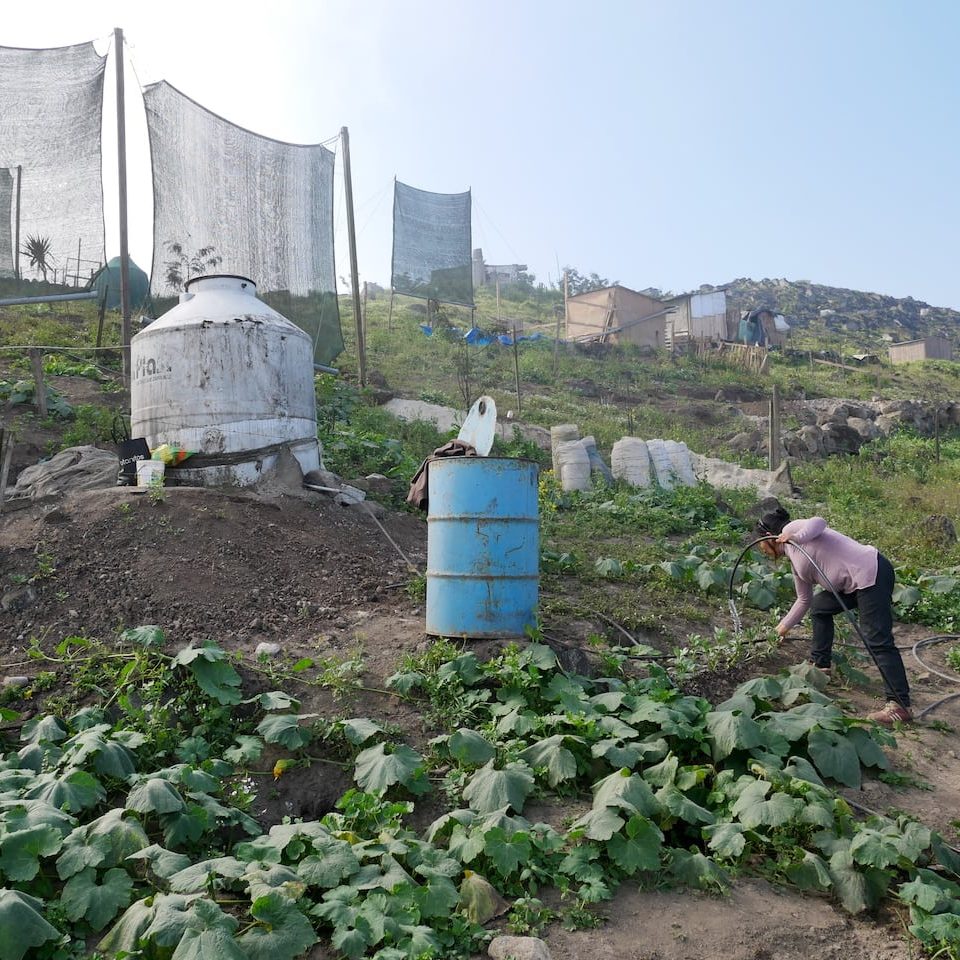Fog catchers (atrapanieblas) are fairly simple constructions. They consist of large plastic or nylon nets stretched between two vertically positioned poles, perpendicular to the direction of the incoming, airborne extension of the ocean, fog. As coastal winds push ground touching clouds toward the net, the air’s capacity to hold water droplets apart and afloat is lowered. Some of the droplets are trapped and gradually trickle down into a slightly inclined gutter that runs horizontally below the lower edge of the mesh, from where the water is then led through a pipe and into a storage tank, sometimes adding up to surprisingly large volumes.
Along the South American Pacific coast, fog catchers have been experimented with at least since the 1980s. In Peru, early experiments were undertaken by scientists interested in using fog as a water source for fog oasis reforestation. Subsequent initiatives have been undertaken also in the hills around the capital, but often to altogether different ends. Initiated by NGOs and civil society associations, these later installations have set out to capture and transform fog into water for settlements (asentamientos humanos) not yet reached by the city’s water infrastructure grid. Accordingly, fog catchers have been understood by some as potential micro-infrastructures able to respond to the absence of more capital-intensive and large-scale water infrastructure supply. However, apart from material remnants and eye-catching videos and newspaper articles, what remains of many such fog capture initiatives is mere disappointment. The grip on the atmosphere afforded by these material assemblages is fleeting, and fog tends to slip into ephemerality again.
I had spent the past month with an NGO known for installing fog catchers in settlements around Lima, and I was interested in learning more about one of their projects, images of which had circulated widely in both national and international media. To my dismay, little of the project remained.
The grip on the atmosphere afforded by these material assemblages is fleeting, and fog tends to slip into ephemerality again.
The mesh must be taken down and protected from the sun each summer, and only a fraction had been put back up again. In addition, I would encounter parts of the fog catchers disassembled and integrated into various auto-construction projects; gutters were attached onto houses, the mesh was used for shading, and the wooden poles had been cut down and repurposed for fences. While my plan to study this system in action seemed thwarted, I was lucky enough to befriend Alejandro and his mother, Rosa, both of whom lived in the area and had much to tell me about the fog catchers.
They recounted how, given the lack of water in their settlement, the NGO’s proposal to provide an off-grid alternative a few years earlier had been gladly received. A few smaller, demonstrative fog catchers substantiated the possibility to trap and transform fog into water in significant volumes, and the NGO director had eventually found some funding. The aim was to expand the number of fog catchers and provide water for multiple uses, including consumption. While Rosa and Alejandro sometimes spoke smilingly about those days, they also expressed deep disappointment. Alejandro called the project a failure (fracaso). It had not met his expectations, and he felt betrayed by the NGO director. Not only did the larger fog catchers fail to produce the volumes of water that had initially been promised, but, in addition, the water was laced with all sorts of heavy metals. In the end, the fog catchers never became a viable alternative to the water trucks they are currently reliant on.
In addition, the water was laced with all sorts of heavy metals.
“A promise is a cloud”
Sandra is a Lima-based artist who had been working with the NGO, Rosa, and Alejandro, as well as some of the other residents around the period of the project’s implementation. Over a coffee, she tells me how she had long been interested in working with fog but never knew how. Fog, she says, is ephemeral and elusive. Unlike the materials that she is used to work with, it cannot be folded or cut. Hence it was only when she learned about the fog catchers that Sandra understood how to engage this “very immaterial material,” as she put it to me. The fog catchers offered a way of rendering fog tangible.
 Artist: Sandra Nakamura. Photographer: Eduardo Hirose.
Artist: Sandra Nakamura. Photographer: Eduardo Hirose.
Her installation consisted of 19 letter-shaped fog catchers. Situated in a row above Alejandro’s settlement, they formed the text “a promise is a cloud” (una promesa es una nube), which Sandra had borrowed from an Arabic proverb. To her, the text expresses the condition of many hill-dwellers around the city. She explains to me that the context from which the proverb had been taken is characterised by aridity. This is the case also in Lima, known as the second largest city in the world built on a desert. At the same time, the refrain gains an additional layer of meaning here, because “we have a constant cloud during the second half of the year, which very rarely produces any rain.” What is more, “the people who are most affected by water scarcity in the city are in majority migrants from other parts of the country, who have come to Lima in search of the promise of fulfilment that the city offers them. But akin to the rain [promised by the cloud], this promise seldom reaches concretisation.”
Sandra further hoped that the NGO-implemented project would help decrease residents’ reliance on water trucks, often criticized by residents for charging expensively and providing water of dubious quality. However, once she returned a few months later to document her installation, Sandra would notice how the mesh had blackened from capturing airborne pollution. Like Rosa and Alejandro, she realized that the water was in no way suitable for potabilization. If she had successfully engaged this otherwise elusive “immaterial material” by rendering ground touching clouds tangible, then maintaining them in this form proved challenging.
The promises that the NGO had made about fog as material possibility had failed to concretise, not unlike the unmet “promises of fulfilment” that Sandra referred to with the refrain. Hence, as I was listening to her, it occurred to me that the fog catchers had themselves become something of a metonym for the very condition that she had intended for her installation to comment on. The NGO-implemented project that Alejandro described as a failure, when interpreted alongside Sandra’s refrain, presented what she intended for her installation to merely allude to representationally. The ground-touching atmospheric phenomenon that the unfulfilled promises of the city had guided the family to, had itself turned out to be a disappointment, thus rendering the blackened mesh of the art installation a material enactment of its own symbolic content.
Desirable and undesirable relations
I am tempted to describe this encounter with the blackened fog catchers as the result of an intervention into the atmosphere that had rendered visible some of its otherwise withdrawn and inconspicuous qualities (Willems 2017). By obstructing fog’s flow, the mesh had translated aspects of the atmosphere into another spatiotemporal scale, whereby airborne particles had become gathered for Alejandro and Sandra to perceive more directly. In other words, this was a sudden exposure of otherwise hidden relations between fog and airborne particles. In addition to the lack of sufficient water, it was this exposure of qualities that fog was not expected to have that impelled Alejandro to conceive of the initiative as a failure.
The project’s failure had oriented his attention to the state and how NGOs often take advantage of the former’s absence and inefficiency.
As I kept listening to him, I noticed how Alejandro often shifted between the scale of the project and the scale of the city and Peru more broadly. The project’s failure had oriented his attention to the state and how NGOs often take advantage of the former’s absence and inefficiency. What Alejandro was talking about was a lack of relations, which was a problem of opposite nature to that which had first led him to think of the project in terms of failure. Whereas the blackened mesh spoke of an excess of undesirable relations between airborne particles and fog, what he was concerned with here was the lack of a series of relations that he thought should be in place.
There are many things that the state demands from you, Alejandro explains to me. There are many things that one is not allowed to do, “because they contradict the Peruvian law.” Likewise, he says that there needs to exist a legal framework for using fog catchers. He is disappointed about the lack of legal criteria for fog-water treatment, and how the NGO could go on with their initiative unobstructed, without facing repercussions. Yet, the relations he deemed desirable went beyond those to the state. They entailed also what he called a “social framework that should be in place, before and after a project.” He complains that there was not a good enough contact between the NGO and the population, and he explains that this was another reason why the project became unsustainable. The excess of undesirable relations between aerosols which had suddenly been brought into view helped orienting Alejandro’s attention to a series of relations that he considered to be absent or insufficiently thick.
Failure’s location
It was indeed the fog catchers’ failure to live up to his expectations that had oriented his attention to a series of absent relations to the state as well as to the NGO. Even so, Alejandro blamed not the fog catchers themselves, for the relational dynamics that the failure had foregrounded spoke of things that stretched well beyond them as material assemblages with clearly defined boundaries.
Rather than having a clearly defined location, the failure had become distributed, relational and, indeed, atmospheric.
This invites a distinction between what Carroll, Jeevendrampillai and Parkhurst call the “materiality of failure” and “material failure” (Carroll et al. 2017: 5). By invoking these terms, they refer not to the more common way of mapping the materiality-materials duality onto a more general separation between representation and world (Ingold 2007). What they have in mind is instead an idea about a given failure’s point of origin and/or reach. That is, the authors distinguish between “some thing that goes wrong,” and situations in which failure “does not rest on, or in, the material thing” itself, but rather in the context around it (Carroll et al. 2017: 5-6, emphasis in original). Whereas the former is described as a material failure, the latter suggests the materiality of failure, which also seemed to be what the project’s failure had brought to Alejandro’s attention.
 Fallen fog catchers in the Atiquipa fog oasis ecosystem. Photo by the author.
Fallen fog catchers in the Atiquipa fog oasis ecosystem. Photo by the author.
What he described as a failure spoke of a series of relations that stretched far beyond the fog catchers themselves, and which needed to become differently configured for fog capture to successfully happen. Rather than having a clearly defined location, the failure had become distributed, relational and, indeed, atmospheric. If failure can be said to be a momentary event, a “moment of breakage between the reality of the present and the anticipated future” (Carroll et al. 2017: 2), then it is also something that may become undone as such by taking on a relational and spatiotemporally distributed form. For Alejandro, a failure to hold airborne water droplets together incentivised him to speculatively envisage the reconfiguration of relations that stretched well beyond the moment and location of the given material failure itself.
References
Carroll, Timothy, David Jeevendrampillai, Aaron Parkhurst, and Julie Shackelford, eds. 2017. The Material Culture of Failure: When Things Do Wrong. London and New York: Bloomsbury Academic.
Ingold, Tim. 2007. “Materials Against Materiality.” Archaeological Dialogues 14 (1): 1-16.
Willems, Brian. 2017. Speculative Realism and Science Fiction. Edinburgh: Edinburgh University Press.
Featured Image
Fog catchers in Lima. Photo by the author.





